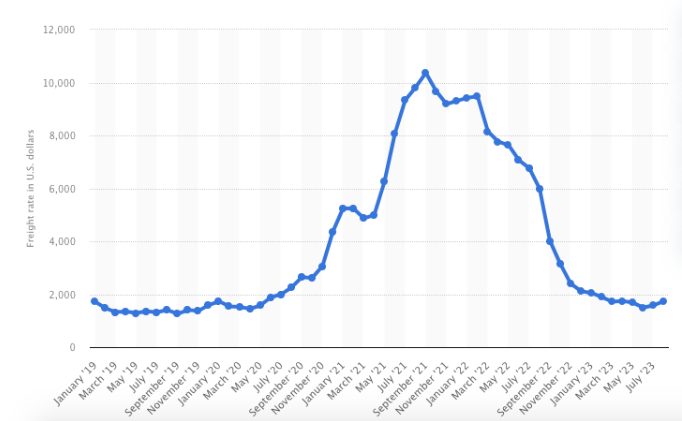Without order fulfillment, there are no sales. That truth only grows in importance during the holiday season. And not just because the holiday season is one of the most important sales periods for most retailers. Failure to meet consumer expectations during the peak period can hurt customer satisfaction and can even lead to holiday anxiety.
But even with the best of efforts, getting your order fulfillment together is a challenge. The holiday season brings order spikes, high demand, and strain on the supply chain.
Still, careful planning with the right strategies can help you manage your problems effectively. Let’s dive into the 2023 holiday season and explore how you prepare for this year's order fulfillment challenges.
General expectations for 2023 holiday shopping
Retail holiday sales in 2023 are projected to grow between 3.5 and 4.5 percent. That results in estimated totals of around $1.54 to $1.56 trillion in sales during the November to January timeframe. In addition, holiday eCommerce sales are anticipated to increase between 10.3 percent to 12.8 percent compared with the same period in 2022. A strong labor market and income growth for the year should offer retailers positive looking sales trends, with overall sales growth a bit lower than last year ( 7.6 percent observed growth in total 2022 holiday sales) but accelerated growth in eCommerce sales ( which grew just 7.9 percent in the 2022 holiday sales season).
Such continued sales growth bodes well, especially since. 2022 generally was a cautious period for consumers. Inflation ate into consumer buying power, and that caused consumers to spread out purchases. People waited for discounts, especially as post-pandemic supply chain issues caused excess inventory to build.
But even with that hesitancy, the run-up to Christmas of 2022 saw positive numbers with online sales. Total retail sales also continued an upward trajectory, despite coming in lower than forecasted at $936.6 Billion.

Source: Statista
That should give merchants relief as economic conditions further stabilize towards the end of 2023. Already, retail and food sales are up this September by 3.8 percent compared to last year. Plus, as of August 2023, personal income in the U.S. increased by $87.6 billion month over month, and personal consumption expenditures by $83.6 billion from the prior month.
Those numbers suggest that consumers are ready with the holiday spirit. Participation levels are back, with 95 percent of consumers planning to purchase during the seasons. Expected average spend is above pre-pandemic levels as well, with people budgeting $1,652 this season’s spending on average. The cost of living crisis may affect consumer demand, but sentiment for 2023 remains stable and healthy.
The state of order fulfillment in 2023
While the overall economic picture appears fine, several unique conditions may challenge your order fulfillment this holiday season:
- Input costs: Despite supply chain disruptions from the war in Ukraine, raw material prices returned to a relative normal. That is matched by changes in the Producer Price Index, where transportation and warehousing prices are down 5.7 percent year over year in September (a rate far lower than May 2022 when the average increase of prices was 23.4 percent). Lower input costs are a positive sign as it reduces order fulfillment and manufacturing expenses. But such rapid changes also put pressure on freight investment. That could lead to cost-cutting and further dysregulation of the shipping industry.
- Container rates: Freight rate drops while largely positive for merchants may also cause problems. August shows a freight rate index of $1,700, a steep decline from the record price of nearly $10,400 in September 2021. Rapid changes can create uncertainty among shippers regarding the investment in container capacity, which affects future delivery times. However, in the short run, lower freight costs suggest that supply exists in the shipping market to meet demand, reducing bottlenecks.

Source: Statista
4 major order fulfillment problems this holiday season
While general shipping and logistics conditions look positive this year, what order fulfilment issues will pop up in the 2023 holiday season? At Justt, we see four primary difficulties:
Return fraud/refund abuse
The average rate of returns in 2022 stayed flat at 16.6 percent of retail sales. But nearly 11 percent of that $212 billion in returns were fraudulent. Such refund abuse only increases during the holiday spike (some research suggests a return rate increase of 2.2 percent in 2023).
Moreover, fraudsters also seem incentivized toward refund abuse. Case in point, there are now guide books that teach consumers how to take advantage of store policies, like Bob’s Refunding eBook. And with 3DS 2.0 implemented widely in Europe as part of PSD2, many fraudsters in European markets moved away from payments from payments fraud to return fraud and refunds abuse. Messing with retailers return and refund policies is currently one of the easiest ways for scammers to make money, especially amid the background noise of the holidays.
Wardrobing
Wardrobing is the unethical practice of using an item with the intention of returning it after use. Such actions hurt product resale value and increase costs through restocking expenses and tie up inventory.
Wardrobing is a form of policy abuse. Lost item value (also known as shrink) accounted for $112.1 billion in losses in 2022, and damage to garments by those engaged in wardrobing may factor into those numbers. It is likely that during this holiday season (and its many gift exchanges) wardrobing will once again occur. It is a holiday issue that needs addressing, as a valuable garment disappears during your best sales opportunity period only to be returned in January.
Lack of adequate inventory management
As demand increases during the holidays, inventory strains. Lack of preparation and incorrect product forecasting often result in missed sales opportunities, customer dissatisfaction, and lost revenue.
But merchants aren’t solely to blame. As already stated, the supply chain for 2023 is still settling. Experts have noted problems with last-mile delivery, cash-strapped small suppliers, strain from multi-channel consumption and geopolitical tensions.
Whatever the proximate cause, shipping volatility threatens the success of your holiday order fulfillment strategy.
Chargebacks
With a simple button-click, a consumer can reverse a legitimate sale. Unfortunately, the spike in card-not-present sales during events such as Black Friday and Cyber Monday also create a spike in payment and friendly fraud. That often results in a subsequent jump in chargebacks as the post-holiday blues set in.
Moreover, consumers appear more open to the use of a chargeback in 2023. Seventy-eight percent of American respondents admitted filing at least one chargeback over the last year, according to a May survey sponsored by Justt. That response share reflects a 12 percent increase over 2022 (66 percent). In addition, 29 percent of Americans engaged in 3 or more chargebacks over the past year, showing greater willingness to use chargebacks by the consumer.
The efficacy of your order fulfillment process directly impacts your chargeback volume. Twenty-seven percent of Americans will wait just 2-3 days for product delivery before filing a chargeback. And only 10 percent will wait more than 15 days. Timely shipments are important to consumers.
And yet, 24 percent of consumers listed “goods or services not received” as the primary reason for filing a chargeback. In addition, thirty-nine percent of stores with both online and in-store presence said “goods not received” was the top non-fraud reason code they did not challenge. There is a disconnect between consumer expectations and merchant fulfillment—and it's resulting in holiday chargebacks.
How to address major order fulfillment issues this holiday season
Luckily, there are several steps you can take to manage each of the above-mentioned order-fulfillment problems:
Return fraud and refund abuse
Defenses against return fraud focus on establishing clear expectations for all your customers and then tracking their behavior across all touchpoints with your business:
- Create a unified view of your operations: Track and monitor all returns. That clarity will help you build a response strategy based on exactly where, when, and how return fraud occurs.
- Tighten refund policies: Discourage fraudsters by removing convenience. Require proof of purchase, establish strict return timeframes, and possibly implement restocking fees for all returns. Note that this may lead to a concomitant rise in chargebacks as first party misusers try other ways to game the system.
- Coordinate departments: Invest in collaboration by sharing data, both cross-departmentally and with other merchants. For example, set up merchandise authorization (RMA) numbers and share all analyzed return patterns.
Prepare for holiday abusers: Create a blacklist of past returns policy abusers, encourage exchanges, and adjust margins on items popular with return fraudsters to recoup losses.
Wardrobing
Wardrobing defenses focus on building fair return policies that specify exact return conditions.
- Define product conditions: Require the presence of original seals, tags, or packaging.
- Educate staff: Teach employees about acceptable physical conditions regarding stains, odors, dirt, and alterations.
- Offer exchanges: If the garment has resale value, exchanges are an excellent way to reduce consumer friction.
Inventory issues
Managing low inventory issues involves preparation and prediction. Here are some possible steps you could take leading up to the holiday season:
- Near-sourcing: Mitigate risk by working closely with vendors who operate near your region. That can help you avoid strained supply chain routes (e.g. East Asia or China). Also, ensure ahead of time that your supplier can meet holiday demand. It might be too late to do this for this year’s holiday season, but it’s not too early to get started on near-sourcing for next year.
- Forecast from historical data: Collect and analyze past holiday data so that you can prepare for similar situations in the future.
- Popular item safety stock: Use extra inventory on select items as a buffer during high demand. Plan for post-holiday clearance sales if you overstock.
- Segment by demand levels: Categorize all products by demand levels specific to the holiday season. Then engage in frequent stock audits on the high-value items.
- Restrict mass purchases: Limit bulk orders to deter bots and resellers, as well as trigger-happy consumers more likely to engage in refund abuse or chargebacks.
Chargebacks
To prevent order fulfillment chargebacks, focus on good customer communications:
- Set clear customer expectations: Make all return, refund, and cancelation policies legible. Create multiple customer touchpoints throughout the buyer’s journey. Use detailed product descriptions.
- Communicate: Collect delivery signatures, offer email updates, track packages, and deliver receipt confirmations. If there are shipment delays, contact the buyer before the 30-day order window closes to improve your odds of winning a dispute.
- Deploy excellent customer service: A good service rep can de-escalate situations that may lead to a dispute. Support service teams by connecting them to delivery, payment, and dispute team data.
- Use a chargeback defense tool: Comprehensive solutions can manage all aspects of the chargeback process. That includes prevention tactics as well as winning disputes after a chargeback is filed.
Conclusion
Order fulfillment during the holiday shopping season is a complex endeavor. Economic expectations for 2023 are positive, but the flurry of holiday activity can expose you to a high volume of chargebacks or return fraud. To succeed, engage in careful planning, optimize your inventory, establish clear refund policies, and build a chargeback defense strategy. Proactive steps will ensure a seamless shopping experience during the festive season.
To learn more about how your company can handle payment disputes that arise from order fulfillment issues read the Justt blog.










